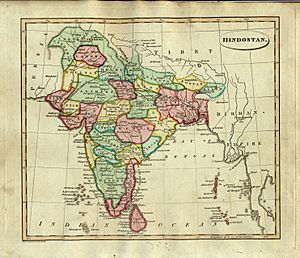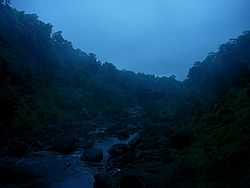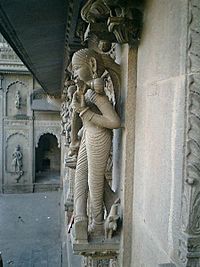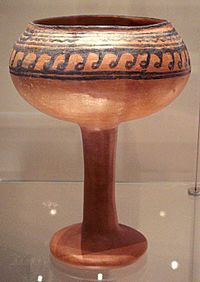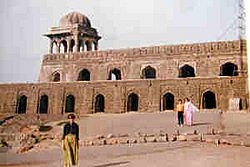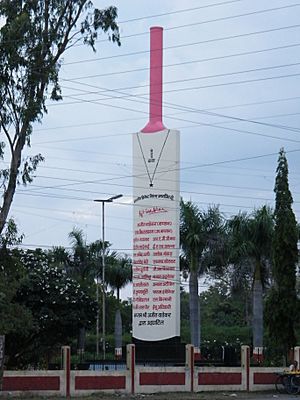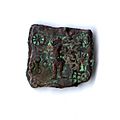Malwa facts for kids
Quick facts for kids
Malwa
|
|
|---|---|
|
Natural region
(former administrative division) |
|
| Country | |
| Area | |
| • Total | 81,767 km2 (31,570 sq mi) |
| Elevation | 500 m (1,600 ft) |
| Population | |
| • Total | 18,889,000 |
| • Density | 231.010/km2 (598.313/sq mi) |
| Languages | |
| • Major languages | Malwi, Hindi |
| • Birth rate | 31.6 (2001) |
| • Death rate | 31.6 (2001) |
| • Infant mortality rate | 93.8 (2001) |
| Time zone | UTC+05:30 (IST) |
| ISO 3166 code | IN-MP |
| Largest city | Indore |
Malwa is a special historical region in west-central India. It sits on a high, flat area called a plateau, which was formed by volcanoes long ago. This Malwa Plateau is mostly the volcanic land north of the Vindhya Range mountains.
Today, the Malwa region includes parts of western Madhya Pradesh and southeastern Rajasthan. Sometimes, it also includes the Nimar region, which is south of the Vindhya mountains.
Malwa has been a separate political area since ancient times. Many powerful kingdoms and rulers have governed it. These include the Mauryans, the Guptas, the Mughals, and the Marathas. Malwa remained an administrative division until 1947. After India became independent, it joined the Madhya Bharat state.
Even though its borders changed often, Malwa developed its own unique culture. This culture was influenced by the people of Rajasthan, Maharashtra, and Gujarat. Many famous people in Indian history lived here. These include the poet Kalidasa and the mathematicians Varahamihira and Brahmagupta. In ancient times, Ujjain was the main city. Today, Indore is the largest city and a big business center.
Most people in Malwa work in agriculture. The region is known for growing certain crops. Textiles, like cloth and fabric, are also a major industry here.
Contents
Exploring Malwa's Geography
The Malwa region is a plateau located in western Madhya Pradesh and southeastern Rajasthan. It is next to Gujarat in the west. The region includes many districts in Madhya Pradesh like Indore, Ujjain, and Dewas. It also covers parts of Rajasthan, such as Jhalawar.
Malwa is surrounded by other regions. To the northeast is Hadoti, and to the northwest is Mewar. The Vindhya Range is to the south and east.
How the Land Was Formed
The plateau is part of the Deccan Traps. These were formed about 60 to 68 million years ago when volcanoes erupted. The soil here is mostly black, brown, and stony. The black soil is like clay and comes from volcanic rock. It is dark because it has a lot of iron. This soil holds water well, so it needs less irrigation. The other types of soil are lighter and have more sand.
Rivers and Mountains
The average height of the plateau is 500 meters (about 1,640 feet). Some peaks are even higher, like Sigar (881 m) and Janapav (854 m). The plateau generally slopes towards the north.
Several rivers flow through Malwa. The Mahi River drains the western part. The Chambal River flows through the center. The Betwa River and others drain the east. The Shipra River is very important historically. A big festival called the Simhasth mela is held there every 12 years.
Malwa's Climate and Seasons
Because Malwa is high up (about 550 to 600 meters above sea level), its evenings are cooler, even when summer days are hot. Even if the day reaches 42-43 degrees Celsius (107-109°F), nights are usually around 20-22 degrees Celsius (68-72°F). This makes the climate much more pleasant than other nearby areas. A cool morning wind, the karaman, and an evening breeze, the Shab-e-Malwa, make summers less harsh. The Mughals gave the evening breeze its name, which means "dusk in Malwa."
The year has three main seasons: summer, the rainy season, and winter.
- Summer is from mid-March to mid-May. The average high temperature is 37°C (98.6°F), sometimes reaching 40°C (104°F).
- The rainy season starts in mid-June and lasts until September. Most rain comes from the southwest monsoon. Indore gets about 90 cm (35 inches) of rain each year.
- Winter is the longest season, from October to mid-March. The average low temperature is 6°C to 9°C (43-48°F), but it can drop to 3°C (37°F). Sometimes, a winter shower called Mawta helps the wheat crops.
Plants and Animals of Malwa
Malwa is part of the Kathiawar-Gir dry deciduous forests ecoregion. The natural plants are mostly tropical dry forests with scattered teak trees. Other common trees include Butea and Acacia. Smaller trees and shrubs like Ziziphus mauritiana are also found.
Common wild animals include Sambhar (a type of deer), Blackbuck (a kind of antelope), and Chinkara (a gazelle). Unfortunately, many forests have been cut down quickly in the last century. This has caused problems like water shortages and the risk of the region turning into a desert.
People and Population
In 2001, about 18.9 million people lived in the Malwa region. The population density was about 231 people per square kilometer. There are many different tribes living in the region.
Malwa's Economy and Work
Indore is the main business city for both Malwa and the state of Madhya Pradesh. Malwa is known for its agriculture. The brown soil in some areas is great for growing crops like wheat and gram (chickpeas). Other crops include millet, maize (corn), and peanuts. Sugar mills are also found in many small towns.
The black, volcanic soil is perfect for growing cotton. Because of this, making textiles (cloth and fabric) is a very important industry. Big textile centers are in Indore, Ujjain, and Nagda. Maheshwar is famous for its beautiful Maheshwari saris. Handicrafts are also a key way for the tribal people to earn money. Things like colored lacquerware from Ratlam and rag dolls from Indore are well-known.
Mandsaur district is the only place in India that produces white and red slate. This slate is used in the district's many slate pencil factories.
Malwa's Rich Culture
Malwa's culture has been greatly shaped by its neighbors, especially Rajasthan. The influence of the Marathas is also strong because they ruled the region more recently.
Language and Food
The main language spoken in Malwa is Malvi, though Hindi is widely used in cities. Malvi is part of the Rajasthani group of languages. There are several dialects of Malvi, like Ujjaini and Rajawari. About 55% of Malwa's people can speak Hindi, which is the official language of Madhya Pradesh.
Traditional Malwa food mixes flavors from Rajasthan, Gujarat, and Maharashtra. In the past, jowar (sorghum) was the main grain. Now, wheat is more common. Many people in Malwa are vegetarian. Because the climate is dry, people often rely on stored foods like pulses. Fresh green vegetables are not always easy to find.
A popular snack is bhutta ri kees, made from grated corn cooked in milk and spices. Baati/bafla is a traditional bread, a small, round ball of wheat flour. Baati is eaten with dal (lentils), while baflas are soaked in ghee and eaten with dal. Sweet dishes include mawa-bati and khoprapak (coconut sweet).
Music and Dance
Lavani is a popular folk music style in southern Malwa. The Bhils, a tribal group, have their own folk songs, always sung with dance. Malwa's folk music often uses four or five notes. Devotional music is also popular. Folk songs often tell stories about famous figures like Raja Bhoj.
Swang is a popular dance-drama form in Malwa. It has ancient roots in Indian theater. Since women did not perform, men played all the roles. Swang includes acting and mimicry, with songs and dialogue.
Art and Paintings
Mandana wall and floor paintings are famous in Malwa. These are white drawings on a base of red clay and cow dung. Common designs include peacocks, cats, and the swastika. Sanjhya is a special wall painting done by young girls during a time when Hindus remember their ancestors.
Malwa miniature paintings are known for their detailed brushwork. In the 17th century, a style called Malwa painting developed. These paintings often have flat designs on dark backgrounds, with figures shown against solid colors.
Festivals and Fairs
The biggest festival in Malwa is the Simhastha mela, held every 12 years in Ujjain. Over 40 million pilgrims come to take a holy dip in the Shipra River. The festival of Gana-gour honors the gods Shiva and Parvati. It symbolizes the annual visits of Rano Bai to her home in Malwa after she married in Rajasthan.
The Ghadlya festival is celebrated by girls. They visit houses carrying earthen pots with lamps inside, singing songs and receiving food or money. The Gordhan festival is celebrated on the 16th day of the month of Kartika. The Bhils sing Heeda songs to their cattle, while women sing Chandrawali songs about Krishna.
Many popular fairs are held throughout the year. The Chaitra fair in Biaora and the Gal yatras in many villages are well-known. The Triveni mela is held in Ratlam.
Discovering Malwa's Tourist Spots
Most tourist places in Malwa are important historical or religious sites. The Shipra River and the city of Ujjain have been considered sacred for thousands of years.
Ujjain: A City of Temples
The Mahakal Temple in Ujjain is one of India's 12 jyotirlingas (sacred Shiva shrines). Ujjain has over 100 other old temples, including Harsidhhi and Chintaman Ganesh. The Kalideh Palace, outside the city, is a beautiful example of ancient Indian architecture. The Bhartrihari caves are linked to interesting legends. Since ancient times, Ujjain has been seen as India's Prime Meridian for Hindu geographers. An observatory built by Jai Singh II has ancient tools for studying stars. The Simhastha mela is a huge festival celebrated here every 12 years.
Mandu: The City of Joy
Mandu was once the capital of the Parmar rulers. In the late 1200s, the Sultans of Malwa took over and named it Shadiabad, meaning "city of joy." They built amazing palaces like the Jahaz Mahal and Hindola Mahal, along with beautiful canals and baths. The huge Jami Masjid and Hoshang Shah's tomb later inspired the design of the Taj Mahal. Other important historical sites include Rewa Kund and Rupmati's Pavilion.
Maheshwar and Dhar
Near Mandu is Maheshwar, a town on the Narmada River. It was once the capital of the Indore state under Rajmata Ahilya Devi Holkar. The Maratha rajwada (fort) is the main attraction there. Dhar was the capital of Malwa before Mandu. Its fort is now in ruins but offers great views. The Bhojashala temple (built in 1400) is still used for worship on Tuesdays.
Indore: A Modern City with History
Modern Indore was planned and built by Rajmata Ahilya Devi Holkar. The grand Lal Baag Palace is one of its most impressive buildings. The Bada Ganpati temple has what might be the world's largest Ganesh idol, standing 7.6 meters (25 feet) tall. The Kanch Mandir is a Jain temple completely covered in glass. The Town Hall, built in 1904, is now called Mahatma Gandhi Hall. The chhatris are tombs built for the Holkar rulers and their families.
Hussain Tekri Shrine
The shrine of Hussain Tekri was built in the 19th century by the Nawab of Jaora. It is on the edge of Jaora in the Ratlam district. During the month of Moharram, thousands of people visit this shrine. It is a copy of the original shrine of Hazrat Imam Hussain in Iraq. The place is known for rituals called Hajri, which are believed to help with mental illness.
Sports in Malwa
Cricket is one of the most popular sports in the Malwa region. Indore is home to the Madhya Pradesh Cricket Association. The city has two international cricket grounds, including the Holkar Cricket Stadium. The first international cricket match in the state was played in Indore.
Images for kids
-
Coin showing Karttikeya and Lakshmi (Ujjain, circa 150–75 BC)
See also
 In Spanish: Malwa para niños
In Spanish: Malwa para niños


